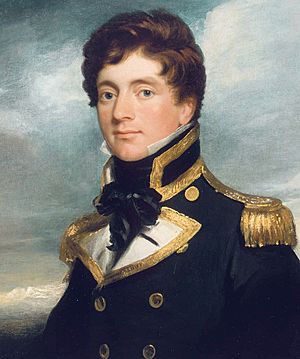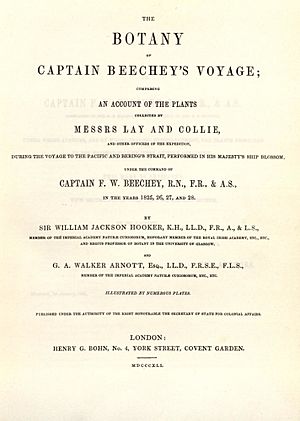Frederick William Beechey facts for kids
Quick facts for kids
Frederick William Beechey
|
|
|---|---|

Beechey painted by his brother
George Duncan Beechey |
|
| President of the Royal Geographical Society | |
| In office 28 May 1855 – 29 November 1856 |
|
| Preceded by | The Earl of Ellesmere |
| Succeeded by | Sir Roderick Murchison |
| Personal details | |
| Born | 17 February 1796 London, Middlesex, England |
| Died | 29 November 1856 (aged 60) London, Middlesex, England |
| Military service | |
| Allegiance | |
| Branch | |
| Service years | 1806–1856 |
| Rank | Rear admiral |
| Commands | HMS Blossom (1806) |
Frederick William Beechey (born February 17, 1796 – died November 29, 1856) was an important English naval officer, artist, and explorer. He was also a hydrographer, which means he mapped oceans and coasts. Beechey wrote books about his exciting journeys.
Contents
Frederick William Beechey: Explorer and Artist
Frederick William Beechey was born in London on February 17, 1796. His parents, Sir William Beechey and Anne Jessop, were both famous painters. Frederick joined the Royal Navy when he was only 10 years old.
He quickly rose through the ranks. By 1807, he was a midshipman. He served in the War of 1812 and even took part in the Battle of New Orleans. Because of his service, he was promoted to second lieutenant in 1815.
Arctic Adventures
In 1818, Beechey joined an Arctic expedition on HMS Trent. He sailed with Lieutenant John Franklin to explore the icy northern regions. Beechey later wrote a book about this trip.
The next year, he joined another Arctic journey with William Edward Parry on HMS Hecla. They sailed very far north, reaching Melville Island.
Mapping the Mediterranean
In 1821, Beechey became an officer on HMS Adventure. This ship was mapping the Mediterranean coast of Africa. He and his brother, Henry William Beechey, explored this coast by land. They published a detailed report of their work in 1828. It was called Proceedings of the Expedition to Explore the Northern Coast of Africa from Tripoly Eastward in 1821-1822.
Exploring the Pacific and Bering Strait
In 1825, Beechey was given command of HMS Blossom. His mission was to explore the Bering Strait. This was a joint effort with other explorers like Franklin and Parry.
In the summer of 1826, Beechey sailed through the strait. A smaller boat from his ship reached a point near Point Barrow. He named this point. It was only 146 miles from where Franklin's expedition had reached from the Mackenzie River.
His voyage on HMS Blossom lasted over three years. During this time, Beechey discovered several islands in the Pacific Ocean. He also found an excellent harbor near Cape Prince of Wales.
Naming Islands
In July 1826, Beechey named three islands in the Bering Strait. Two of them were the Diomede Islands, which Vitus Bering had named earlier. Beechey called them "Ratmanoff Island" (now Big Diomede) and "Krusenstern Island" (now Little Diomede). He named the third, uninhabited island "Fairway Rock", which is still its name today.
One of his crew members, John Bechervaise, wrote a detailed book about the voyage in 1839. In 1831, Beechey himself published his own account. It was called Narrative of a Voyage to the Pacific and Bering's Strait to Co-operate with the Polar Expeditions, 1825-1828.
Later Achievements
From 1835 to 1836, Captain Beechey worked on mapping the coast of South America. Then, from 1837 to 1847, he did similar work along the coasts of Ireland, the North Sea, and the English Channel.
He carried out important studies of the tides during this time. He published his findings with charts in 1848 and 1851. This was the first time such detailed tidal charts had been published since the early 1700s.
In 1850, he was put in charge of the Marine Department of the Board of Trade. He became a rear admiral in 1854. The next year, he was elected president of the Royal Geographical Society.
Beechey Island, an island where Sir John Franklin's expedition spent a winter, was named by Frederick William Beechey after his father.
Family of Painters
Frederick William Beechey came from a very artistic family. His parents were both painters. Three of his brothers were also painters: Richard Brydges Beechey, Henry William Beechey, and George Duncan Beechey. His daughter, Frances Anne Hopkins, also became a painter. She lived in Canada for 12 years and created many famous paintings of canoe travel.
See also
 In Spanish: Frederick William Beechey para niños
In Spanish: Frederick William Beechey para niños
- European and American voyages of scientific exploration



